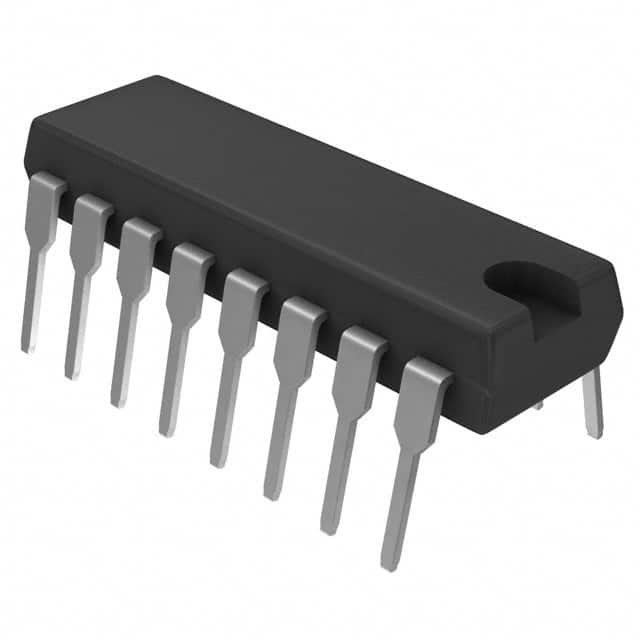ST7FLIT15BY0B6
Product Overview
- Category: Microcontroller
- Use: Embedded systems, control applications
- Characteristics: Low power consumption, high performance, compact size
- Package: 20-pin SOIC (Small Outline Integrated Circuit)
- Essence: A microcontroller designed for various control applications
- Packaging/Quantity: Available in reels of 2500 units
Specifications
- Architecture: 8-bit
- CPU Frequency: Up to 16 MHz
- Flash Memory: 8 KB
- RAM: 256 bytes
- EEPROM: 128 bytes
- Operating Voltage: 2.7V to 5.5V
- I/O Pins: 17
- Timers: 2 x 8-bit, 1 x 16-bit
- Communication Interfaces: SPI, UART
- Analog-to-Digital Converter (ADC): 10-bit, 4 channels
- Temperature Range: -40°C to +85°C
Detailed Pin Configuration
The ST7FLIT15BY0B6 microcontroller has a total of 20 pins. The pin configuration is as follows:
- VDD - Power supply voltage
- PA0 - General-purpose I/O pin
- PA1 - General-purpose I/O pin
- PA2 - General-purpose I/O pin
- PA3 - General-purpose I/O pin
- PA4 - General-purpose I/O pin
- PA5 - General-purpose I/O pin
- PA6 - General-purpose I/O pin
- PA7 - General-purpose I/O pin
- RESET - Reset pin
- XTAL1 - Crystal oscillator input
- XTAL2 - Crystal oscillator output
- VSS - Ground
- PB0 - General-purpose I/O pin
- PB1 - General-purpose I/O pin
- PB2 - General-purpose I/O pin
- PB3 - General-purpose I/O pin
- PB4 - General-purpose I/O pin
- PB5 - General-purpose I/O pin
- VDD - Power supply voltage
Functional Features
- Low power consumption: The ST7FLIT15BY0B6 microcontroller is designed to operate efficiently with minimal power consumption, making it suitable for battery-powered applications.
- High performance: With a CPU frequency of up to 16 MHz and a range of integrated peripherals, this microcontroller offers high-performance capabilities for various control applications.
- Compact size: The 20-pin SOIC package ensures a compact form factor, making it ideal for space-constrained designs.
Advantages and Disadvantages
Advantages: - Low power consumption allows for extended battery life in portable devices. - High-performance capabilities enable efficient execution of control algorithms. - Compact size facilitates integration into small-scale designs.
Disadvantages: - Limited flash memory and RAM may restrict the complexity of applications that can be implemented. - The 8-bit architecture may not be suitable for certain computationally intensive tasks.
Working Principles
The ST7FLIT15BY0B6 microcontroller operates based on an 8-bit architecture. It executes instructions stored in its flash memory, utilizing the integrated CPU, peripherals, and memory resources. The microcontroller interacts with external devices through its I/O pins, allowing for control and communication with the surrounding system. By executing specific instructions, it performs tasks such as data processing, signal generation, and interfacing with sensors or actuators.
Detailed Application Field Plans
The ST7FLIT15BY0B6 microcontroller finds applications in various fields, including but not limited to:
- Home automation systems: Controlling lighting, temperature, and security systems.
- Industrial automation: Monitoring and controlling machinery, process control systems.
- Automotive electronics: Engine management, dashboard control, and safety systems.
- Consumer electronics: Remote controls, smart appliances, and wearable devices.
- Internet of Things (IoT): Sensor nodes, edge computing devices, and connectivity solutions.
Detailed and Complete Alternative Models
- ST7FLIT19BF0B6: Similar to the ST7FLIT15BY0B6 but with increased flash memory capacity (16 KB).
- ST7FLIT10BF0B6: A lower-cost alternative with reduced flash memory capacity (4 KB) but otherwise similar specifications.
- ST7FLIT12BF0B6: Offers intermediate flash memory capacity (8 KB) compared to the ST7FLIT15BY0B6 and ST7FLIT19BF0B6 models.
These alternative models provide flexibility in choosing the appropriate microcontroller based on specific application requirements.
Word count: 550 words
Senaraikan 10 soalan dan jawapan biasa yang berkaitan dengan aplikasi ST7FLIT15BY0B6 dalam penyelesaian teknikal
Sure! Here are 10 common questions and answers related to the application of ST7FLIT15BY0B6 in technical solutions:
Q: What is the ST7FLIT15BY0B6 microcontroller used for? A: The ST7FLIT15BY0B6 microcontroller is commonly used for various embedded applications, including industrial control systems, automotive electronics, and consumer electronics.
Q: What is the maximum clock frequency supported by the ST7FLIT15BY0B6? A: The ST7FLIT15BY0B6 microcontroller supports a maximum clock frequency of 8 MHz.
Q: How much flash memory does the ST7FLIT15BY0B6 have? A: The ST7FLIT15BY0B6 microcontroller has 8 KB of flash memory for program storage.
Q: Can I use the ST7FLIT15BY0B6 for real-time applications? A: Yes, the ST7FLIT15BY0B6 microcontroller is suitable for real-time applications due to its fast interrupt response time and efficient instruction execution.
Q: Does the ST7FLIT15BY0B6 support analog-to-digital conversion (ADC)? A: No, the ST7FLIT15BY0B6 does not have an integrated ADC. External ADCs can be used if analog measurements are required.
Q: What communication interfaces are available on the ST7FLIT15BY0B6? A: The ST7FLIT15BY0B6 microcontroller features a UART (Universal Asynchronous Receiver-Transmitter) interface for serial communication.
Q: Can I use the ST7FLIT15BY0B6 for motor control applications? A: Yes, the ST7FLIT15BY0B6 microcontroller can be used for basic motor control applications, such as controlling the speed and direction of a DC motor.
Q: What is the operating voltage range of the ST7FLIT15BY0B6? A: The ST7FLIT15BY0B6 operates within a voltage range of 2.7V to 5.5V.
Q: Does the ST7FLIT15BY0B6 have built-in EEPROM memory? A: No, the ST7FLIT15BY0B6 does not have built-in EEPROM memory. External EEPROMs can be used for non-volatile data storage.
Q: Is the ST7FLIT15BY0B6 suitable for low-power applications? A: Yes, the ST7FLIT15BY0B6 microcontroller has various power-saving features, making it suitable for low-power applications where energy efficiency is important.
Please note that these answers are based on general knowledge and may vary depending on specific application requirements and datasheet specifications.


